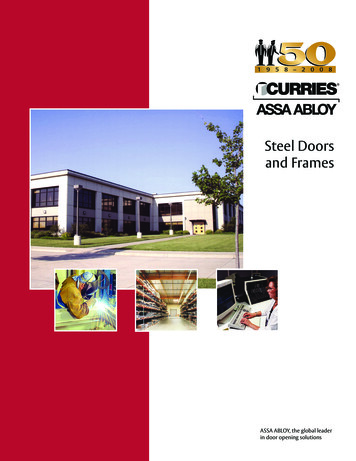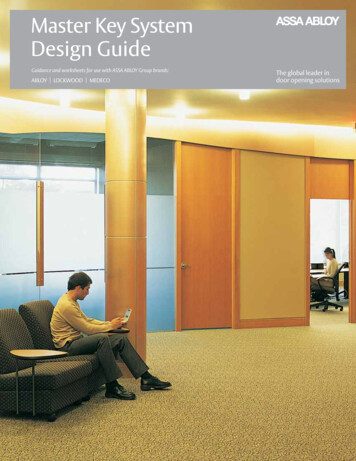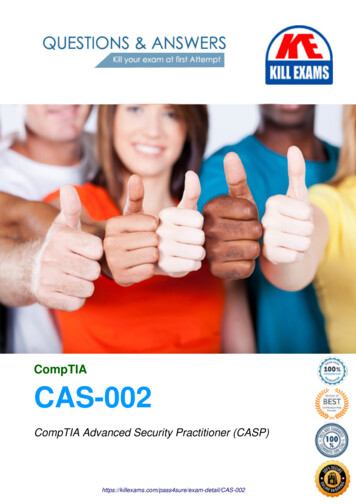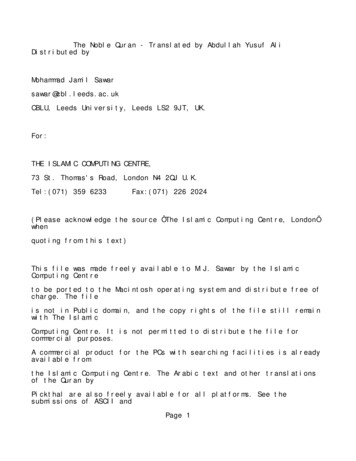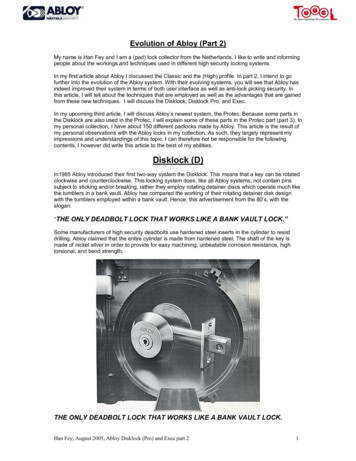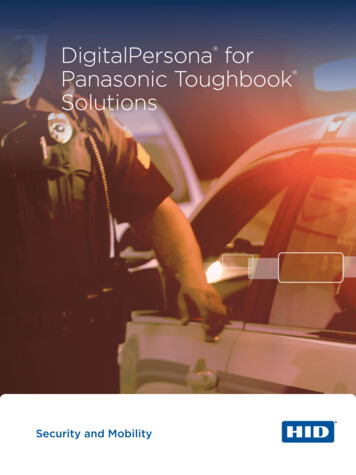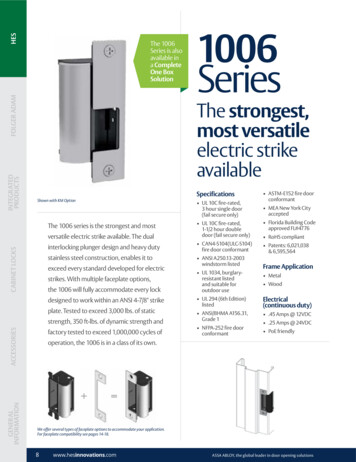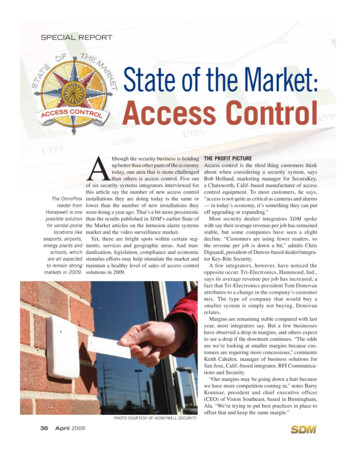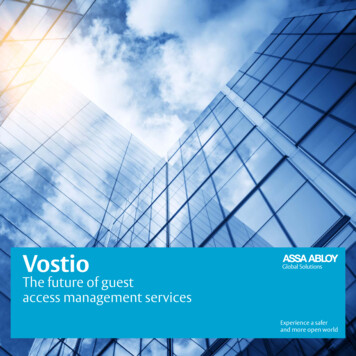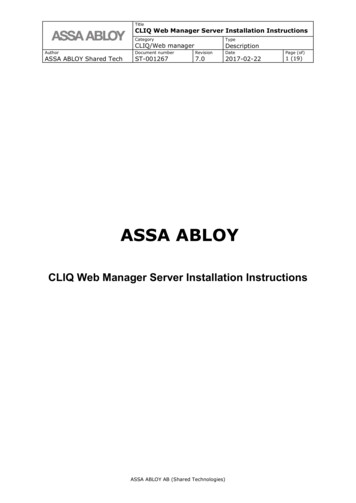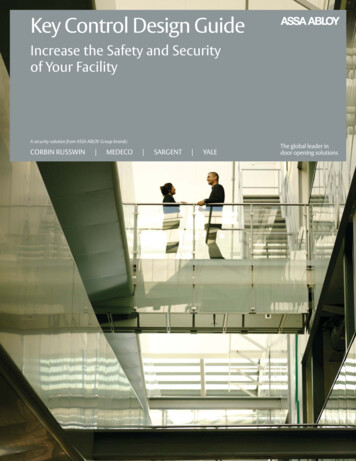
Transcription
Key Control Design GuideIncrease the Safety and Securityof Your FacilityA security solution from ASSA ABLOY Group brands:CORBIN RUSSWIN MEDECO SARGENT YALE
ContentsI. Introduction . . . . . . . . . . . . . . . . . . . . . . . . . . . . . . . . . . . . . . . . . . . . . . . . . . . . . . . . . . . . . . . . . . . . . . . . . . . . 2II. Recommended Companion Document . . . . . . . . . . . . . . . . . . . . . . . . . . . . . . . . . . . . . . . . . . . . 3III. Comprehensive Model Key Control Policya. Purpose . . . . . . . . . . . . . . . . . . . . . . . . . . . . . . . . . . . . . . . . . . . . . . . . . . . . . . . . . . . . . . . . . . . . . . . . . . . . . . . . . 4b. Specification. . . . . . . . . . . . . . . . . . . . . . . . . . . . . . . . . . . . . . . . . . . . . . . . . . . . . . . . . . . . . . . . . . . . . . . . . . . . 5c. Enforcement . . . . . . . . . . . . . . . . . . . . . . . . . . . . . . . . . . . . . . . . . . . . . . . . . . . . . . . . . . . . . . . . . . . . . . . . . . . . 6d. Elements of a Key Control Policy . . . . . . . . . . . . . . . . . . . . . . . . . . . . . . . . . . . . . . . . . . . . . . . . . . . . . . . . 7Key Control Authority (KCA). . . . . . . . . . . . . . . . . . . . . . . . . . . . . . . . . . . . . . . . . . . . . . . . . . . . . . . . . . 7Storage. . . . . . . . . . . . . . . . . . . . . . . . . . . . . . . . . . . . . . . . . . . . . . . . . . . . . . . . . . . . . . . . . . . . . . . . . . . . . . . 7Key Management Formats . . . . . . . . . . . . . . . . . . . . . . . . . . . . . . . . . . . . . . . . . . . . . . . . . . . . . . . . . . . . 8Record Keeping . . . . . . . . . . . . . . . . . . . . . . . . . . . . . . . . . . . . . . . . . . . . . . . . . . . . . . . . . . . . . . . . . . . . . 10Policies and Procedures . . . . . . . . . . . . . . . . . . . . . . . . . . . . . . . . . . . . . . . . . . . . . . . . . . . . . . . . . . . . . 101. Identifying Keys and Keying2. Issuing Keys3. Returning Keys4. Non-returned key policy5. Administration of the Master Key System6. Audits7. Transfer/Temporary useForms . . . . . . . . . . . . . . . . . . . . . . . . . . . . . . . . . . . . . . . . . . . . . . . . . . . . . . . . . . . . . . . . . . . . . . . . . . . . . . . 13Servicing . . . . . . . . . . . . . . . . . . . . . . . . . . . . . . . . . . . . . . . . . . . . . . . . . . . . . . . . . . . . . . . . . . . . . . . . . . . . 15IV. Condensed Model Key Control Policy . . . . . . . . . . . . . . . . . . . . . . . . . . . . . . . . . . . . . . . . . . . . . 16V. Specific Applications:a.b.c.d.Educational K-12. . . . . . . . . . . . . . . . . . . . . . . . . . . . . . . . . . . . . . . . . . . . . . . . . . . . . . . . . . . . . . . . . . . . . . . 18Healthcare Facilities . . . . . . . . . . . . . . . . . . . . . . . . . . . . . . . . . . . . . . . . . . . . . . . . . . . . . . . . . . . . . . . . . . . 19Colleges and Universities . . . . . . . . . . . . . . . . . . . . . . . . . . . . . . . . . . . . . . . . . . . . . . . . . . . . . . . . . . . . . . 21Office Buildings. . . . . . . . . . . . . . . . . . . . . . . . . . . . . . . . . . . . . . . . . . . . . . . . . . . . . . . . . . . . . . . . . . . . . . . . 22VI. Glossary of Terms and Definitions. . . . . . . . . . . . . . . . . . . . . . . . . . . . . . . . . . . . . . . . . . . . . . . . . . 23 ASSA ABLOY SALES & MARKETING GROUP INC. 2005, 2006, 2007. All rights reserved.3
IntroductionThis “Key Control Design Guide” is brought to you byASSA ABLOY, the world’s leading group of manufacturersand suppliers of locking solutions, dedicated to satisfyingend-users’ needs for security and safety.Providing key systems and associated hardware is onlythe beginning. For end-users to successfully enjoy thebenefits of the products we furnish, and to extend thelife and value of a key system, proper policies must be inplace. The policies and procedures suggested in thismanual can play an essential part in increasing the safetyand security of any facility. This manual should be usedas a model or guide only. End-users are encouraged toadopt all or part of the recommendations as appropriateto meet their individual needs.Disclaimer: ASSA ABLOY encourages the use in whole orpart of this document but does not imply or warrantfitness for any purpose other than for reference only. Itsuse in whole or part is solely the decision andresponsibility of the adopting facility.4 ASSA ABLOY SALES & MARKETING GROUP INC. 2005, 2006, 2007. All rights reserved.
Recommended Companion DocumentMaster Key System Design Guide and WorksheetsIn addition to establishing strong key control policies that govern the distribution andmanagement of keys, building an effective physical master key system is crucial to achieving thedesired level of security. To that end, ASSA ABLOY offers the “Master Key System Design Guide”,a comprehensive guidebook on setting up a master key system. Worksheets make it easy for theuser to begin to lay out a system.Once the process begins, it’s important to rely upon an expert who can help design a securemaster key system and select the right cylinder for each opening. ASSA ABLOY’s team of trainedand certified Key System Specialists will help you develop and implement an effective master keysystem and the appropriate key control policies. Contact your local ASSA ABLOY Door SecuritySolutions sales team to speak with a Key System Specialist. ASSA ABLOY SALES & MARKETING GROUP INC. 2005, 2006, 2007. All rights reserved.5
Comprehensive Key Control Policya. Purpose1. The purpose of this Key Management Policy is to help protect the life, property,and security of this facility and all its occupants.2. It shall serve as the framework by which all keys and access credentials will bemanaged, issued, duplicated, stored, controlled, returned, replaced, and accountedfor by the Key Control Authority (“KCA”).2.1. The KCA comprises the person, persons, department, or committee that hasauthority to adopt, administer, and enforce this facility’s Key Management Policy.2.2. This policy shall apply to all keys including those to all space, office equipment,vehicles, padlocks, lockers, safes, etc. owned, operated, or controlled by the facility.3. This Policy seeks to establish a recorded chain of accountability and access for allcredentials, keyholders, and locations.3.1. Establish a key issuance authority.3.2. Issue appropriate level keys to individuals.3.3. Establish authority on all key control policies.4. This policy seeks to implement a proper key control process and then preserve it byrestoring security in a timely manner whenever key control has been threatened orcompromised.6 ASSA ABLOY SALES & MARKETING GROUP INC. 2005, 2006, 2007. All rights reserved.
b. Specification1. This facility shall use a key control system and adopt administrative policies thatfacilitate the enforcement of Key Management Procedures as outlined in thisKey Control Design Guide.2. The following represent the basic and most critical elements of key control andshall be included, as a minimum, in the key control specification.2.1. Facility shall appoint a Key Control Authority and/or Key Control Manager toimplement, execute, and enforce key control policies and procedures.2.2. A policy and method for the issuing and collecting of all keys shall be implemented.2.3. Keys and key blanks shall be stored in a locked cabinet or container, in asecured area.2.4. A key control management program shall be utilized. A dedicated computersoftware application is preferred—Key Wizard or equivalent.2.5. All keys shall remain the property of the issuing facility.2.6. A key should be issued only to individuals who have a legitimate and officialrequirement for the key.2.6.1. A requirement for access alone, when access can be accomplished byother means (such as unlocked doors, request for entry, intercoms,timers, etc.), shall not convey automatic entitlement to a key.2.7. All keys shall be returned and accounted for.2.8. Employees must ensure that keys are safeguarded and properly used. ASSA ABLOY SALES & MARKETING GROUP INC. 2005, 2006, 2007. All rights reserved.7
c. Enforcement1. This policy shall be adopted by universal consent and administrative mandate fromthe highest levels to allow full and complete implementation and enforcement.2. All keys remain the property of facility.3. Keys that are no longer required for authorized purposes shall be returned to theKey Control Authority (KCA).4. No person or department shall knowingly receive, borrow, or possess any key for anyspace without receiving permission from a person duly authorized to give permissionto possess such key.5. No person shall knowingly alter, duplicate, copy, or make a facsimile of any key to alock of a facility building or property without receiving permission from the KCA.6. To enforce effective key control, administrators may choose to impose a deposit foreach key issued.7. Keyholders shall use assigned keys for access to authorized locks only.8. Keyholders shall take measures to protect and safeguard any facility keys issued tothem or in their name.9. Keyholders shall not loan their facility key(s).10. Keyholders shall not use their key(s) to grant access to non-authorized individuals.11. Keyholders shall not attempt in any manner to duplicate or alter facility keys intheir possession.12. Keyholders shall immediately report any lost, missing, stolen or damaged keys.13. Persons entering locked buildings or spaces are responsible for re-securing all doors and shallnot prop open any doors.14. Individuals shall not store keys in desk drawers or other unsecured areas.15. Violations of any of these enforcement policies may result in disciplinary actionup to and including dismissal.8 ASSA ABLOY SALES & MARKETING GROUP INC. 2005, 2006, 2007. All rights reserved.
d. Elements of a Key Control PolicyKey Control Authority—“KCA”1. Facility shall appoint a Key Control Authority with power and authority to:1.1. Develop all the policies and procedures related to the facility’s key management system.1.2. Appoint or become a Key Control Manager to:1.2.1. Implement, execute and enforce the key control policies and procedures.1.2.2. Issue and return keys with proper documentation, authorization, andtransaction receipts.1.2.3. Supervise, authorize, and control the security of key and key blank storageand the key cutting process.Storage1. Keys, credentials, and key records shall be stored in a secure condition (data) or location(physical items) protected by lock and key or vault.1.1. Keys shall be stored in a locked cabinet or container, in a secured area.1.2. Key rings issued for temporary use shall be of a tamper resistant design so that keyscannot be removed from the ring prior to return.1.3. Keys stored in a non-centralized location:1.3.1. Sequence locks release one key upon the insertion and trapping of another.1.3.1.1. Allows remote issuance of master keys.1.3.1.2. Permits fewer master keys to be issued on a permanent basis.1.3.2. Emergency key storage boxes (Knox, Supra type).1.3.2.1. Subject to local regulations and to protect against theft or duplication, nomaster keys should be stored in these types of containers.1.3.3. Computerized key cabinets with access control and audit capability may be usedin remote locations for temporary key issuance.1.4.Key records shall be stored in a secure location that is protected against both fireand theft:1.4.1. Bitting lists.1.4.2. Authorization forms.1.4.3. Key issuance and return records.1.4.4. Data files shall be password protected and encrypted. ASSA ABLOY SALES & MARKETING GROUP INC. 2005, 2006, 2007. All rights reserved.9
Key Management FormatsThe key management system shall be maintained in either a manual orcomputerized format.1. The manual format shall use card and index files to easily access, maintain, andcross-reference information on:1.1.Keys:1.1.1. Blind code numbers.1.1.2. Standard Key Coding Symbols (“SKCS”).1.1.3. Key identity: serial, inventory, or sequence number.1.1.4. Individuals with authority to issue for each key.1.1.5. Temporary issue keys and key rings.1.2.Keyholders:1.2.1. Name, address, ID #, telephone, key deposit.1.2.2. Authorized individual’s signature.1.2.3. Optionally: signature, photo, PIN.1.2.4. Key deposit (if any).1.3.Locations:1.3.1. Room number.1.3.2. Door number.1.3.3. Description or usage.1.3.4. Departmental control.1.3.5. Security level or access restrictions.1.4.Hardware:1.4.1. Lockset, exit devices, deadbolt.1.4.2. Cylinder type.1.4.3. Door closer.1.4.4. Hinges.1.4.5. Finish.1.4.6. Protection plates.10 ASSA ABLOY SALES & MARKETING GROUP INC. 2005, 2006, 2007. All rights reserved.
2. The computerized format shall use password protected and data encrypted software to easilyaccess, maintain, and cross-reference information on:2.1. Keys:2.1.1.2.1.2.2.1.3.2.1.4.2.1.5.2.2.Blind code numbers.Standard Key Coding Symbols (“SKCS”).Key identity: serial, inventory, or sequence number.Individuals with authority to issue for each key.Temporary issue keys and key rings.Keyholders:2.2.1. Name, address, ID #, telephone, key deposit.2.2.2. Authorized individual’s signature.2.2.3. Optionally: signature, photo, PIN.2.2.4. Key deposit (if any).2.3. Locations:2.3.1. Room number.2.3.2. Door number.2.3.3. Description or usage.2.3.4. Departmental control.2.3.5. Security level or access restrictions.2.4. et, exit devices, deadbolt.Cylinder type.Door closer.Hinges.Finish.Protection plates.3. Either format used shall allow a fully searchable cross-reference:3.1.3.2.3.3.3.4.3.5.3.6.Keys x location(s).Keys x keyholder(s).Keyholder x keys.Keyholder x location(s).Location x key(s).Location x keyholder(s). ASSA ABLOY SALES & MARKETING GROUP INC. 2005, 2006, 2007. All rights reserved.11
Record Keeping1. All key records shall be kept current at all times and are to be considered high securityand confidential.2. Records shall be securely stored (see “Storage”).3. All transactions shall be recorded in a timely manner.4. Standardized forms shall be used (see “Forms”).Policies and Procedures1. Identifying Keys and Keying1.1. All keys should only be marked with a blind code number that does not in anyway reflect its usage or level.1.2. The use of standard key coding to mark cylinders or keys is not recommended.1.3. Keys should not be marked M, MK, GMK, or GGMK to indicate level of keying.1.4. All issued keys should contain an inventory or serial number that reflects the totalnumber of keys issued and provides a unique identifier for every copy.1.5. Keys should not be stamped with bittings.2. Issuing Keys2.1. All key orders should be properly authorized by an authorized signer, in addition tothe keyholder, before issuing.2.1.1. Each key can have its own appropriate level of authorization.2.1.1.1. Higher level keys may require higher levels of authorization.2.2. Issue the proper level key to each individual granting only the appropriate level of access.2.3. Issue keys by need, not desire.2.4. Require signature(s) on keyholder agreement:2.4.1. Signature of keyholder.2.4.2. Signature of authorizer.2.5. Require photo ID.2.6. Keys shall be issued by duration of need, not by term of employment.2.7. Signature required by keyholder and authorizer.2.8. Keys must be personally picked up, not mailed.2.8.1. If necessary, keys may be delivered by courier or other return-receipt-requiredcertified carrier.12 ASSA ABLOY SALES & MARKETING GROUP INC. 2005, 2006, 2007. All rights reserved.
2.9. Keys shall be individually serialized or numbered.2.9.1. Keys shall be identified by blind code numbers and serialized number.2.10. Individuals may be issued only one copy of each keyset.2.10.1. Exception for approved multiple key holders.2.11. The KCA shall establish key issuance authorization levels determined by the type of key. Thegeneral rule shall be that an authorizer may only approve keys for spaces directly underhis/her control. In some cases more than one authorizer may be required.2.11.1. Types of keys:2.11.1.1. Change keys.2.11.1.2. Master keys.2.11.1.3. Grand master keys.2.11.1.4. Top master key.2.11.1.5. Entrance key.2.11.1.6. Control keys.2.11.1.7. Mechanical/Maintenance keys.2.11.1.8. SKD/Security keys.2.12. Facility shall use standardized key deposits varying by keyholder type and by level of key.For example, the deposit for a master key should be greater than that of a change key.2.13. Keys may not be duplicated or issued except through the KCA or authorized facilitylocksmith.2.14. Keys shall only be issued by a designated individual.2.14.1. Exception: electronic key cabinets with audit control or sequence locks.2.15. All keys should be tracked with a return due date and time, especially temporary issue keys.2.16. Shift keys or rings shall be returned at the end of every work shift.2.17. Shift key rings shall be sealed and tamper evident.3. Returning Keys3.1. All keys shall be returned to the issuing department by the authorized keyholder.3.1.1. When keys are returned, any key deposit will be refunded and a key returnreceipt shall be issued to the keyholder.3.2. Found keys must be turned into the KCA.3.3. Final paychecks, records, and/or transcripts may be held pending return of key(s). ASSA ABLOY SALES & MARKETING GROUP INC. 2005, 2006, 2007. All rights reserved.13
4. Non-returned key policy4.1. A fee for lost or stolen keys shall be established.4.1.1. In the event that facility keys are lost or stolen, it shall be policy to recombinateimmediately any cylinders accessible by the lost key(s).4.1.2. All re-keying charges must be paid by department, individual, or companyresponsible for losing the key.4.1.3. Rekeying charges shall be determined by the number of locks operated bythe lost or stolen key(s).4.1.4. If any individual has two or more separate incidents of lost, stolen, or nonreturned key violations within a one-year period, key privileges may be revoked.5. Administration of the Master Key System5.1. Update the key schedule and bitting lists as new codes and bittings are issued and used.5.1.1. Send periodic updates to the cylinder manufacturer if factory control over thekey system will continue.5.2. Cross keyed conditions should be minimized or avoided.5.2.1. When cross keying is unavoidable, all cross keyed conditions should befully recorded.6. Audits6.1. Keyholder:6.1.1. On at least an annual basis, the responsible department will determine thatthe proper accountability of keys is being maintained by conducting random keychecks that sample the keys being carried by at least 25% of all departmentalkeyholders.6.2. Key System:6.2.1. It is recommended that, under normal circumstances, all keys and cylindersshould be changed, or at least evaluated for change, at intervals not exceedingfive years.6.2.2. Perform periodic audits of key cutters to determine if unauthorized duplicatekeys can be obtained.6.3. Reports shall be periodically generated and distributed by department with a writtenresponse required to confirm the accuracy of the information being held.7. Transfer/Temporary use7.1. Keys shall not be transferred from one individual to another without properauthorization and record keeping from the KCA.14 ASSA ABLOY SALES & MARKETING GROUP INC. 2005, 2006, 2007. All rights reserved.
FormsIt is highly recommended that forms be developed to document all key transactions.The following represents basic elements that should be included in one or more of each type ofform — See example next page.1. Key Request Form1.1. Key request:1.1.1. One form for one key.1.1.2. Issue multiple forms for multiple keys.1.2. Key issue agreement.1.3. Keyholder signature.1.4. Authorization signature.1.5. Work order.1.6. Key issue and deposit receipt.1.7. Multiple keyholder request.2. Key Return Form2.1. Key return receipt.2.2. Deposit return receipt.3. Lost or Stolen Key Report Form3.1. Description of circumstances of loss.3.2. Rekey fee if any.4. Service Form4.1. Cylinder recombination form.4.2. Request for SKD or NMK keying.4.3. Lock opening request form.The following basic information should be included on each form.1. Key holder name, address, ID and/or department.2. Signature of key holder and date.3. Key identification (key set symbol and/or blind code).4. Location where key(s) are needed.5. Type of transaction; issue, return, lost or stolen, cylinder recombination,or lock opening request.6. Authorization signature(s).7. Date of specific transaction(s). ASSA ABLOY SALES & MARKETING GROUP INC. 2005, 2006, 2007. All rights reserved.15
Key Request Form(Use one form for each key only)NameEmployee ID# PhoneKey# Key Symbol Copy# MfgrKeyLocation(s)Key Issue Agreement: In return for the loan of this key, I agree: 1) not to give or loan the key to others; 2) not to make anyattempts to copy, alter, duplicate, or reproduce the key; 3) to use the key for authorized purposes only; 4) to safeguard and storethe key securely; 5) to immediately report any lost or stolen keys; 6) produce or surrender the key upon official request. I alsoagree that if the key is lost, stolen, or not surrendered when requested a charge that reflects the cost of changing any and all locksaffected may be assessed.Signature DateDepositIssue Type: StandardTemporaryDue DateReissueReasonAuthorizer’s Signature DatePrint NameKEY RETURN:TitleRETURN DATE BYPhoneRETURN REASONOFFICIAL USE ONLYDEPOSIT RETURNKEY NOT RETURNED:DATE ISSUED LOST STOLEN BROKEN OTHEREXPLAIN CIRCUMSTANCES:BYCONTROL #SIGNATURE RECEIPTENTERED BYBY ASSA ABLOY SALES & MARKETING GROUP INC. 2005, 2006, 2007. All rights reserved.
Servicing1. Cutting keys:1.1. Only a facility-approved locksmith shall be permitted to cut keys.1.2. All facility keys shall be cut on factory approved code cutting machines, not onduplicating machines that trace from one key to another. Duplicating machines areless accurate and can transfer wear or inaccuracy that worsens through generationsof keys.2. Pinning/recombinating cylinders:2.1. Shall only be performed by facility-approved locksmith department.2.2. Shall be on the facility’s key system unless approved by KCA.2.2.1. Combinate to all appropriate levels of keying unless pre-approved by KCA.2.2.2. SKD combinations must be pre-approved by KCA.3. Installing locks:3.1. Shall only be performed by facility-approved locksmith department.3.2. Shall be on facility’s key system unless approved by KCA.4. Preventative maintenance shall be performed regularly to ensure proper operation of keysand locks and to maintain security.4.1. Worn keys shall be replaced to avoid breakage.4.2. Worn or poorly functioning cylinders shall be replaced to maintain proper security.4.3. All facility key machines shall be checked and calibrated regularly, at least on a monthlybasis.5. Locksmithing work shall only be performed by:5.1. An in-house locksmith department, or5.2. A facility-approved outside locksmith business. ASSA ABLOY SALES & MARKETING GROUP INC. 2005, 2006, 2007. All rights reserved.17
Condensed Model Key Control PolicyThe following is to be used as a guide for developing a key control policy, and to assist in theunderstanding of how a formalized key control policy should be formatted. When used inconjunction with the Key Control Policy Elements of ASSA ABLOY’s Key Control Design Guide, thissample key control policy can be tailored to meet a facility’s specific key management objectives.PurposeThe purpose of this Key Control Policy is to help protect the life, property, and security of thisfacility and all its occupants.SpecificationThis facility shall use a key control system and administrative policies that facilitate the adoptionand enforcement of this Key Control Policy.GeneralThe introduction of a key control policy is essential for the security of this facility and theprotection of personnel, property, and equipment.Facility shall appoint a Key Control Authority with power and authority to: develop all policies andprocedures related to the facility’s key management system; and, appoint or become the KeyControl Manager to execute and enforce key control policies and procedures.The Locksmith Shop (internal or contracted service), unless otherwise directed, is responsible formaking keys, installing and maintaining locks and cylinders.No person shall knowingly alter, duplicate, copy, or make a facsimile of any key to a lock of abuilding or property thereof without receiving permission from a person duly authorized.Key ControlThe Key Control Authority will determine appropriate policy and method for the issuing andcollecting of all keys.All keys shall be stored in a secured locked cabinet.The Key Control Authority shall utilize an effective key control management program and assignthe appropriate individual(s) to maintain its use.To facilitate effective key control, the Key Control Authority may impose a nominal key deposit.18 ASSA ABLOY SALES & MARKETING GROUP INC. 2005, 2006, 2007. All rights reserved.
Policy and ProceduresIssuing of KeysAll keys remain the property of(Insert name of facility).All keys shall be properly authorized by signature before issuing, and shall only be issued by adesignated individual.The process for which keys shall be issued will be based on defined policies and procedure asset forth by the Key Control Authority.Keys should be issued only to individuals who have a legitimate need for the key.The number of master keys issued should be limited.Returning KeysAll keys shall be returned to the issuing department by the keyholder of record.All lost keys shall be reported immediately to the Key Control Authority. It shall be the facility’spolicy that when keys are lost or stolen, to recombinate immediately any cylinders accessed bythe lost keys.All found keys shall be returned to the Key Control Authority.Employee ResponsibilitiesEmployees shall only use their keys to access their assigned work areas and should lock doorswhen leaving any secured area. Employees must also ensure that keys are safeguarded andproperly used.The unauthorized possession, use or reproduction of a key may constitute theft ormisappropriation. Any employee who violates this policy may be subject to disciplinary action. ASSA ABLOY SALES & MARKETING GROUP INC. 2005, 2006, 2007. All rights reserved.19
Specific Applicationsa. Educational K-12Following are specific examples of additional elements that should be considered when tailoringa key control policy for Educational, K-12 facilities:1. K-12 facilities require heightened lock and key management to protect a highly vulnerablepopulation of students and staff.1.1. Any policy must restrict the distribution and ensure the retrieval of keys.1.2. Access through entrance doors must be tightly controlled.1.3. Threats: drugs, kidnapping, vandalism, terrorism, violence, abuse.2. Lockdown conditions and procedures.3. Limited school year with extended periods of vacation or closure that require returnof keys or lock-out of many keyholders.4. Community usage and access requirements:4.1. Special access authorization requirements.4.2. Special requirements for unlocking requests.5. A school district may have many buildings, often spread over a wide geographical area.5.1. This may require special considerations for service, remote key duplication andissuance.6. Unique types of keyholders:6.1. Teachers.6.1.1. Keys should normally be returned at end of academic year.6.2. Substitute teachers.6.2.1. Temporary issued keys.6.3. Administration.6.4. Maintenance/Service/Security.7. Administered by local government and subject to state, federal, and local laws.20 ASSA ABLOY SALES & MARKETING GROUP INC. 2005, 2006, 2007. All rights reserved.
b. Healthcare FacilitiesFollowing are specific examples of additional elements that should be considered when tailoring akey control policy for Healthcare facilities.Healthcare facilities, including hospitals, clinics, and nursing homes provide unique demandsupon a key system. Facilities protecting a more vulnerable population, such as children, the sickor infirm, the aged, those with infectious diseases, those susceptible to infection, or those withmental impairment, even including the criminally insane, can present a diverse set of needs.Some of those considerations are:1. Healthcare facilities (“HCF’s”) may require a strong KCA that can enforce key issuanceand return policies despite the strong needs and powerful personalities of doctors andadministrators.2. HIPPA privacy requirements.3. HCF’s have different departments with varying security needs:3.1. Obstetrics.3.2. Pediatric wards.3.3. Psychiatric detention areas.3.4. Infectious disease areas.3.5. Emergency rooms.3.6. Elderly care with anti-wandering requirements.3.7. Unique elevator controls.3.8. Pharmacy: storage and dispensary.3.9. Security department with full access abilities.3.10. Custodial and cleaning staff must have full access to keep high sanitation standards.3.11. Radiology.3.12. Laboratories.4. HCF’s often allow free access, 24x7x365, to visitors and attendants, but still require a highdegree of control within the building itself. ASSA ABLOY SALES & MARKETING GROUP INC. 2005, 2006, 2007. All rights reserved.21
5. An HCF may have many buildings united under one key system.6. Unique types of Keyholders:6.1. Doctors.6.2. Nurses.6.3. Administrators.6.4. Maintenance and technicians.6.5. Cleaning supervisors.6.6. Security.6.7. Temporary staff with high turnover.6.8. Outside contractors.6.9. Researchers.7. Unique accreditation and federal, state and local government inspection and legal requirements.22 ASSA ABLOY SALES & MARKETING GROUP INC. 2005, 2006, 2007. All rights reserved.
c. Colleges and UniversitiesFollowing are specific exa
1. The purpose of this Key Management Policy is to help protect the life, property, and security of this facility and all its occupants. 2. It shall serve as the framework by which all keys and access credentials will be managed, issued, duplicated, stored, controlled, returned, replaced, and accounted for by the Key Control Authority ("KCA .
